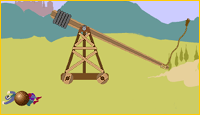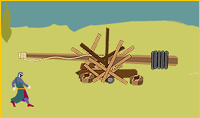
|
 |
Destroy the Castle > How Your Trebuchet Works Ball Weight Provided with the same amount of energy, lighter balls launched from a trebuchet will fly farther than heavier ones. This makes sense in our everyday experience: Using the same arm, you can throw a baseball quite a bit farther than you can a bowling ball, for example. However, the ball's weight affects more than the distance it will fly. A lighter ball traveling at the same velocity as a heavier ball will land with less force. That's why some of the lighter stone balls launched in our trebuchet simulation hit the mark, yet bounce off harmlessly. The stone's mass is not great enough to break through the sturdy castle wall.  With too heavy a ball, you may suffer the same fate as you
wished to inflict upon your enemy: The ball could fly straight
up and back down. That's because your trebuchet cannot provide
enough energy to counteract the pull of gravity that holds
your heavy ball down.
With too heavy a ball, you may suffer the same fate as you
wished to inflict upon your enemy: The ball could fly straight
up and back down. That's because your trebuchet cannot provide
enough energy to counteract the pull of gravity that holds
your heavy ball down.
 There is danger, as well, in erring in the direction of too
light a ball. Too light a ball might not be able to accept all
the energy that the trebuchet's swinging arm can deliver.
Where does the energy go? It may go into the trebuchet's axle
pivot, its base, or into its scaffolding, destroying your
trebuchet rather than the enemy castle's wall.
There is danger, as well, in erring in the direction of too
light a ball. Too light a ball might not be able to accept all
the energy that the trebuchet's swinging arm can deliver.
Where does the energy go? It may go into the trebuchet's axle
pivot, its base, or into its scaffolding, destroying your
trebuchet rather than the enemy castle's wall.
Medieval Arms Race | NOVA Builds a Trebuchet | Life in a Castle Destroy the Castle | Resources | Transcript Medieval Siege | Pharaoh's Obelisk | Easter Island | Roman Bath | China Bridge | Site Map Editor's Picks | Previous Sites | Join Us/E-mail | TV/Web Schedule About NOVA | Teachers | Site Map | Shop | Jobs | Search | To print PBS Online | NOVA Online | WGBH © | Updated November 2000 |